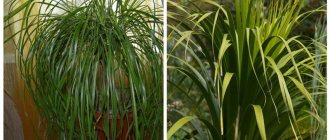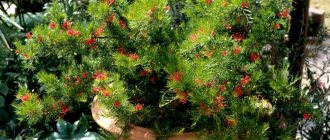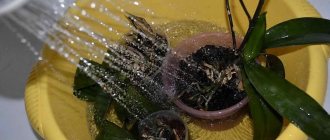Author: Elena N. https://floristics.info/ru/index.php?option=com_contact&view=contact&id=19 Category: Houseplants Published: December 12, 2013Last edits: January 11, 2021
- Nolina longifolia / Nolina longifolia
Botanical description
Nolina (lat. Nolina) belongs to the Asparagus family of plants, mainly growing in natural conditions in the southern United States and Mexico. Another botanical name for the plant is Bocarnea, and it is popularly called “Horse Tail” because of the shape and arrangement of the leaves, or “Elephant Foot” because of the shape of the trunk. Indoor nolina is usually a low plant. This is a bottle plant - the nolina trunk expands at the base. This extension serves as a water reservoir that helps the plant survive long dry periods, and the thin leaves allow moisture to evaporate slowly, making the plant resistant to moisture stress. Growing the plant is quite simple. The pot needs to be shallow, since the root system does not go deep - in nature, nolina grows on rocky soils. The plant is grown as an ornamental deciduous plant, since it is almost impossible to achieve flowering indoors. Looks good as a single plant.
Nolina from seeds
Propagating nolina by seeds usually does not cause any difficulties. Before sowing, you need to disinfect them with a solution of potassium permanganate and disinfect the soil in the microwave.
Sowing is carried out to a depth of 1 cm in a moistened substrate, then the seed container is placed in a warm place, for example, above heating pipes, and subsequently the soil is not allowed to dry out.
The seedlings that appear after a month must be placed in the most illuminated place; under no circumstances should they be fertilized. After another 1 month, the young animals should be seated in separate containers.
Briefly about cultivation
- Flowering: grown as an ornamental foliage plant and does not bloom indoors.
- Lighting: bright diffused light throughout the year.
- Temperature: in spring and summer - normal for residential premises; in winter, the plant should be kept at 10-12 ºC, but the temperature should be lowered gradually.
- Watering: using the bottom watering method: in spring and summer - abundantly, after the earthen lump in the pot has completely dried, in winter watering is scanty.
- Humidity: normal.
- Fertilizing: nolina does not need fertilizer, but if necessary, add a solution of mineral fertilizer, the concentration of which is four times weaker than suggested in the instructions.
- Dormant period: from November to March.
- Transplantation: after a dormant period: up to 3-4 years - annually, for older nolins - once every 2-3 years.
- Substrate: 2 parts sand and one part each of peat and leaf soil.
- Reproduction: seeds and shoots.
- Pests: mealybugs, scale insects and spider mites.
- Diseases: trunk rot.
Read more about growing nolina below.
Nolina feeding
The growth of nolin at a young age is characterized by a fairly rapid pace. As a result, by 6-7 years, with skillful care, they become large outdoor plants. This assumes that there is no need for additional feeding, although, if desired, it can be done periodically (once every 3 weeks) for these purposes.
Use liquid mineral mixtures, reducing the fertilizer concentration recommended in the instructions for use by 1.5-2 times. Fertilizing can be done only during active growth and is done only after abundant watering.
Caring for nolina at home
Lighting
Lighting throughout the year should be bright but diffuse. Exposure to direct sunlight is harmful for nolina at home, so the plant is grown on eastern and western windows, and on southern windows they are placed at a distance. In winter, during the dormant period, nolina needs bright light, so additional artificial lighting may be required.
Temperature
In summer and spring during the growing season, room temperature is suitable; no special conditions need to be created. If in winter it is possible to keep indoor nolina at a temperature of about 10-12 °C, by September the temperature is gradually reduced, preparing the plant for the dormant period. If in winter the plant grows at temperatures above 18 °C, then there will be no dormant period, and the nolina flower will continue to grow all year round. In summer, the plant can be taken outside, covering it from precipitation and wind. A draft can destroy the plant.
Watering Nolina
In spring and summer, water abundantly, but rarely. How this is done: a pot of nolina is lowered into a container of water and taken out when the soil is completely wet, after which the excess water is allowed to drain for half an hour. Next time you will need to water only after the entire earthen ball has completely dried out. Overmoistening of the soil is detrimental to the plant. The houseplant nolina should be watered in the same way if it overwinters at high temperatures. If in winter the temperature drops below 15 °C, then water less often and more carefully, and if wintering takes place at 10 °C and below (dormant period), then nolina is not watered. If you pour nolina indoors in winter (at low temperatures), this will most likely lead to the death of the plant.
- Crassula – Money tree – Crassula
Spraying
Spraying is not at all necessary when growing indoors, since spraying is more conducive to wetting the soil - in nature, the leaves of the nolina plant collect dew, which flows to the center of the rosette and along the trunk to the soil. You can sometimes spray the plant and wipe the nolina leaves with a damp cloth. You need to take soft, settled water, or better yet, boiled water.
Top dressing
Homemade nolina grows beautifully and quite quickly even without fertilizing if you care for it properly. You can also feed, but only in half the concentration and only during the growing season (spring and summer). Complex mineral fertilizers are suitable for feeding and are applied no more than once every 20 days. Before fertilizing, the nolina plant needs to be watered, or better yet, it should be fed after the plant has been watered.
Nolina transplant
Nolina is planted and replanted in low but wide pots, since the plant’s root system is superficial, which is due to the plant’s natural habitat – rocky, infertile soils. A decent thickness of drainage layer is poured onto the bottom of the pot, which will allow excess water to drain away. The soil is made up of two parts sand and one part each of leaf soil and peat. Another option is to mix leaf, turf, humus soil, sand and peat in equal parts. The simplest option is to mix coarse sand and garden soil in equal parts, you can add small pebbles. Nolina is replanted after the roots completely fill the pot. Plants up to 3-4 years of age are replanted every year, and older specimens - every 2-3 years. Plants are planted at the same depth and watered only after 4-5 days.
Growing from seeds
Nolins at home are mainly propagated by seeds, although this is a complex process. For sowing, use a soil mixture of equal parts of peat and sand. Before sowing, seeds should be soaked in water or a growth stimulant for 1-2 days. After this, they are laid out on the substrate at a distance of 2 cm from each other, and sprinkled with the same substrate in a layer equal to the width of the seed. The pot with the crops is placed in a bright place and kept under fluorescent lamps at night. The temperature is not allowed to drop below 20 °C, and optimally 24-25 °C. The container with nolina seeds is covered with film and ventilated from time to time when condensation appears. Moisten the soil very carefully so that it does not dry out, but is not flooded with water. Shoots will appear within a month. When they get stronger, they are planted in separate pots in the soil, which is described above in the “Transplanting” paragraph. They are cared for as for adult specimens.
Reproduction by shoots
The nolina flower also reproduces by shoots. First, you need to carefully separate the side shoot, after which it is planted in a pot with a substrate of equal parts of vermiculite, sand and peat. You need to make a small hole with a peg in the substrate, place the shoot in this hole and lightly press down the soil around the shoot. The container with the plant is placed in a bright, warm place (about 24-25 °C), covered with a glass jar. The jar is removed from time to time, the pot is ventilated, and the soil is sprayed. When the nolina has a couple of new leaves, the jar is removed, and the plant gradually begins to be cared for as an adult plant.
Reproduction of nolina by lateral shoots
Under the layer of nolina bark, dormant buds sometimes wake up. This is how side stems begin to grow, which can be used for propagation. Having separated the lateral shoot from the parent, you should soak it in a phytohormone solution for a day to stimulate root formation.
Next, it needs to be placed in the soil at an angle, covered with a transparent cap and placed in a warm room. If the root system of the planted stem is formed before the leaves begin to feel “thirsty,” there is a chance of success.
Diseases and pests
New nolina leaves grow small and pale. Most likely these are the consequences of growing with insufficient lighting and high air temperatures.
- Crassula at home, types and varieties
Nolina's leaf tips turn brown. This is a common problem with many indoor plants. The reason is too dry air in the room.
The nolina trunk becomes thin. In nolina, this happens, as in other bottle plants, due to excess moisture. If watering is frequent, and the soil does not have time to dry out between them, then the trunk becomes thin because it does not accumulate moisture as unnecessary. In order for the trunk to have the shape of a bottle, it is necessary to allow the earthen clod to dry completely between waterings.
The trunk of the nolina is rotting. The reason is excess moisture in the soil, too frequent watering. It is worth watering only when the soil is dry.
Nolina pests. Rarely affected by pests, but can be attacked by mealybugs, scale insects or spider mites. To reduce the likelihood of damage, air humidity should not be low, and the leaves should be wiped with a damp cloth from time to time.
Nolina watering
This plant has adapted to collect moisture, and therefore in the summer months hydration is reduced to moderate watering - the lump of earth should be wetted completely and the procedure should be repeated only after the soil has completely dried, and not immediately, but after a few days.
With the onset of winter and the establishment of a cool environment, watering ends - these are the most pleasant resting conditions for the plant. If the temperature has not dropped, continue to water as usual.
It is also worth noting that nolina does not require spraying at home, but the leaves must be systematically wiped with a soft, damp sponge.
Kinds
Nolina longifolia / Nolina longifolia
Another botanical name is Beaucarnea longifolia. In our area they are grown in greenhouses, since it is extremely difficult to create suitable conditions in apartments. In nature, this species is represented by trees with a powerful trunk covered with corky bark. Old leaves dry out and fall along the trunk, thereby forming something like a skirt. It blooms with numerous whitish-cream flowers, which are located on a large paniculate inflorescence.
Nolina Lindemeira / Nolina lindheimeriana
Like other species, this one has a second name - Beaucarnea lindheimeriana. This species has practically no trunk, and the leaves are thin and long, but very strong. The plant is popularly called "devil's lace." This species is probably the lowest. It blooms with small flowers on small paniculate inflorescences. In cultivation it is found only in greenhouses and botanical gardens.
Nolina matapensis / Nolina matapensis
Also known as Beaucarnea matapensis. Representatives of this species are taller than Lindemeyra nolina, but are still considered low-growing plants - reaching no more than 2 m in height. Old leaves dry out and droop, forming a kind of skirt on the trunk. The flowers are yellow-white, collected in large paniculate inflorescences. This species is not grown indoors.
- Begonia: growing at home
Nolina recurvata
Another name is Beaucarnea recurvata. The trunk has a bottle shape, expanding towards the base, in natural conditions reaches 10 m in height, and in indoor conditions - up to 2 m. The leaves are long, narrow, linear in shape, grow at the top of the trunk, forming a rosette; and hang down. Nolina leaves are dark green in color, leathery to the touch, grow up to 1 m in length and up to 2 cm in width. Over time, the trunk becomes bare at the bottom. The leaves serve as raw materials in the production of sombreros and baskets. Flowering in indoor conditions practically does not happen; in nature it blooms with cream flowers, which are located on a paniculate inflorescence.
How to choose when purchasing?
If you don’t have nolina yet, but you are determined to add this plant to your flower collection, you’ll have to look for it on the open market.
There are several selection criteria, and it is worth paying attention to the following characteristics:
- brightness of foliage color (leaves should be rich dark green);
- absence of dark spots, drying out or rotting places;
- abundance of freely hanging foliage (on adult plants, narrow and long leaves should form a voluminous “crown”, without bald spots).
In addition, there is no need to ignore deep cracks or wrinkles on the tree trunk, which indicates a violation of the conditions of maintenance of the selected specimen.
Choosing trusted and reputable points of sale will help increase the chances of a successful purchase, but it is better to avoid dubious sellers in spontaneous markets. Did you know? Mexicans have long made headdresses from long nolina leaves (especially the famous sombrero hats) and weaved baskets that can withstand heavy weight (up to 10 kg or more).
What to do with the seeds
How to grow nolina from seeds? Before planting, be sure to sort the seeds by size, since large grains germinate much faster than small ones. After this, separate the substandard seeds.
It's easy to do. To do this, prepare a weak solution of salt or manganese and pour the seeds into it. They should remain in solution for 24 hours. During this time, good grains will swell and sink to the bottom of the container, while empty seeds will remain afloat. Sow only those seeds that have sunk.
A peat-sand mixture is best suited for sowing. Mix the components in equal proportions. Experienced gardeners recommend keeping the container with soil in a steam bath for 30 minutes before sowing. This time is enough for the death of insect larvae and harmful microorganisms that may be present in the soil.
As you already know, nolina can survive for a long time without moisture. Also, for the germination of its seeds, a lot of moisture is not required. Just moisten the soil a little. You can use moisture stabilizers such as vermiculite or perlite. Add them to the soil, but not more than a quarter of the container’s volume. To be on the safe side, make drainage at the bottom of the container.











